Abstract
Sequence polymorphism of class II major histocompatibility complex-encoded molecules (Ia) not only accounts for the allelic variability in Ia structure relevant to T-lymphocyte responses but also seems to result in differential quantitative expression of particular Ia heterodimers. The contributions of different allelically variable regions of Ia molecules to both of these processes were analyzed by transfection of L cells with various A beta and A alpha gene pairs. The results show that, with regard to quantitative and qualitative aspects of Ia expression, the polymorphisms in the A beta chain segregate into two groups. Those in the NH2-terminal half of A beta 1 have a consistent role in controlling beta-alpha chain interactions, efficiency of dimer expression, and Ia conformation and probably are in the interior of the Ia molecule at the site of beta-alpha domain interaction. Polymorphisms in the COOH-terminal half of A beta 1 contribute to those structures that directly interact with antibodies, antigen, and/or T-cell receptors, consistent with their presence on the surface of the Ia heterodimer. This analysis provides a model for understanding both overall class II molecular structure and the relationship between this structure and immune recognition. It also suggests an explanation for the evolution of certain features of class II genes.
Full text
PDF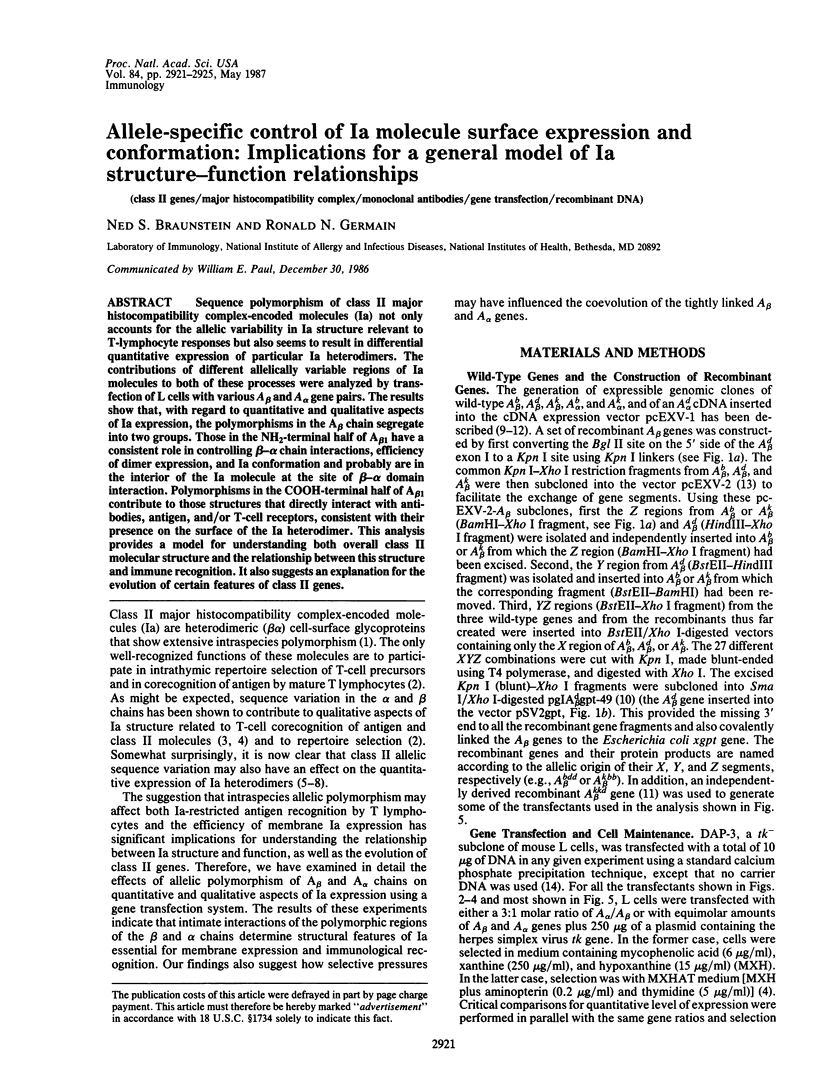
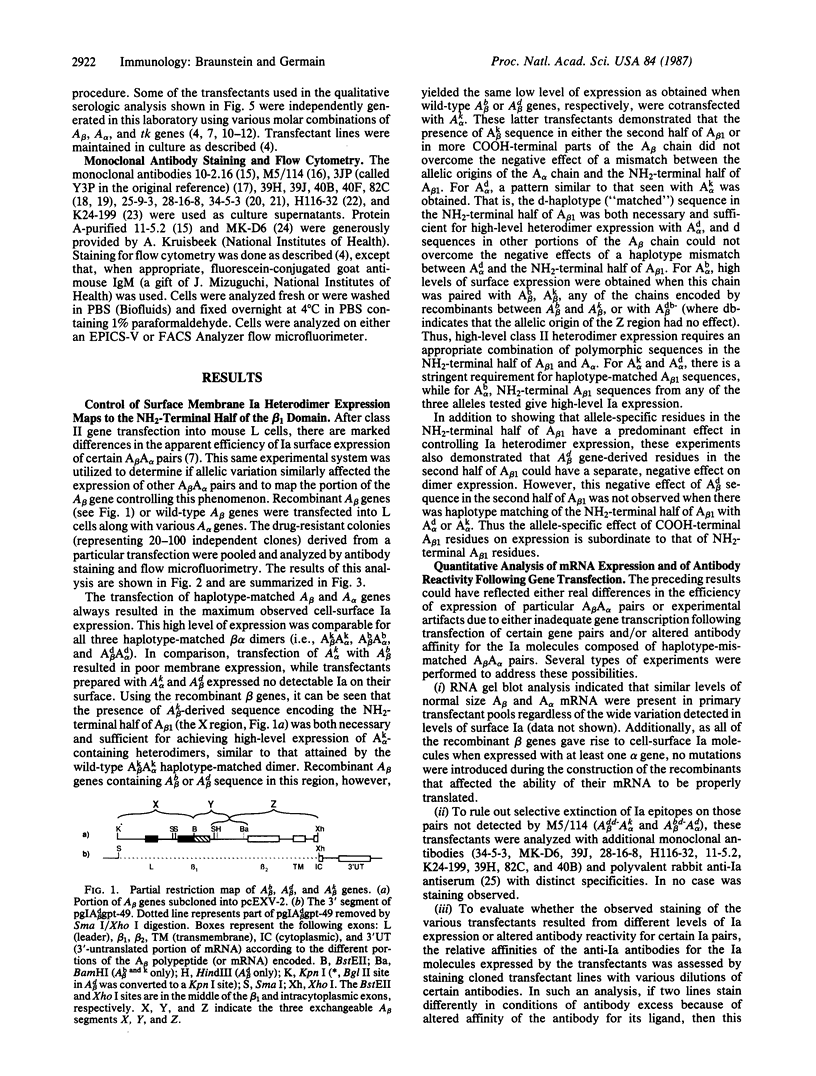
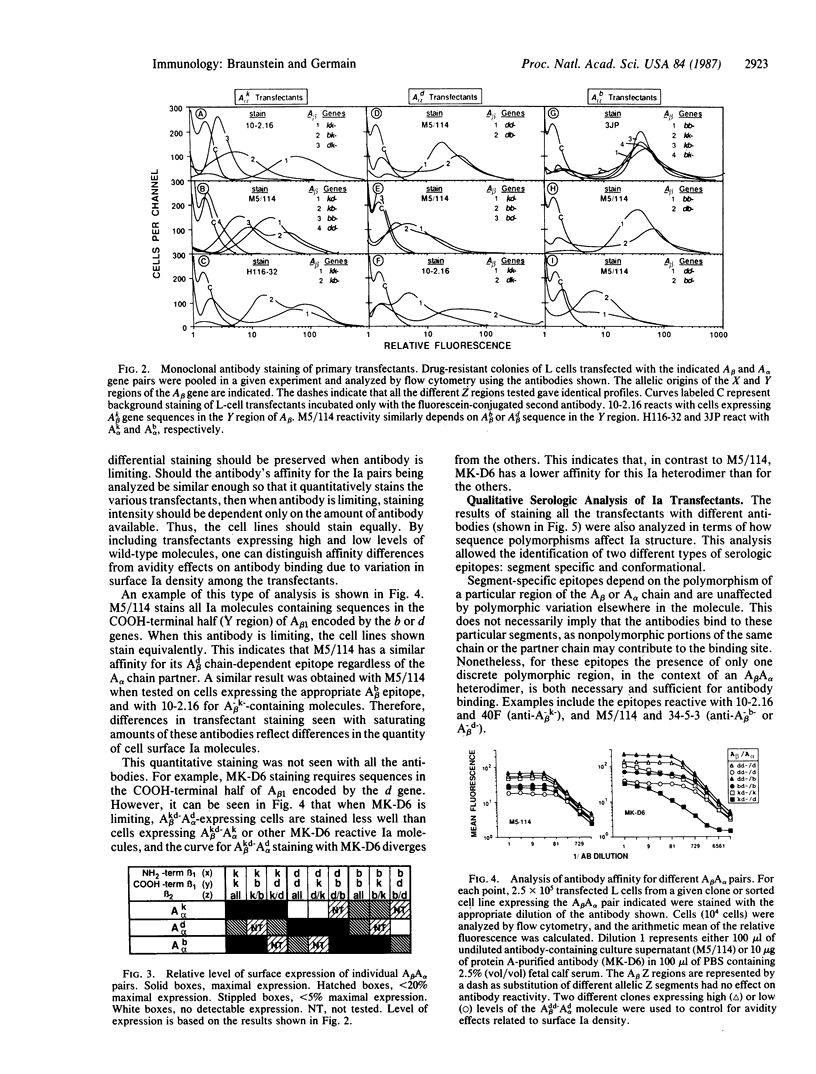
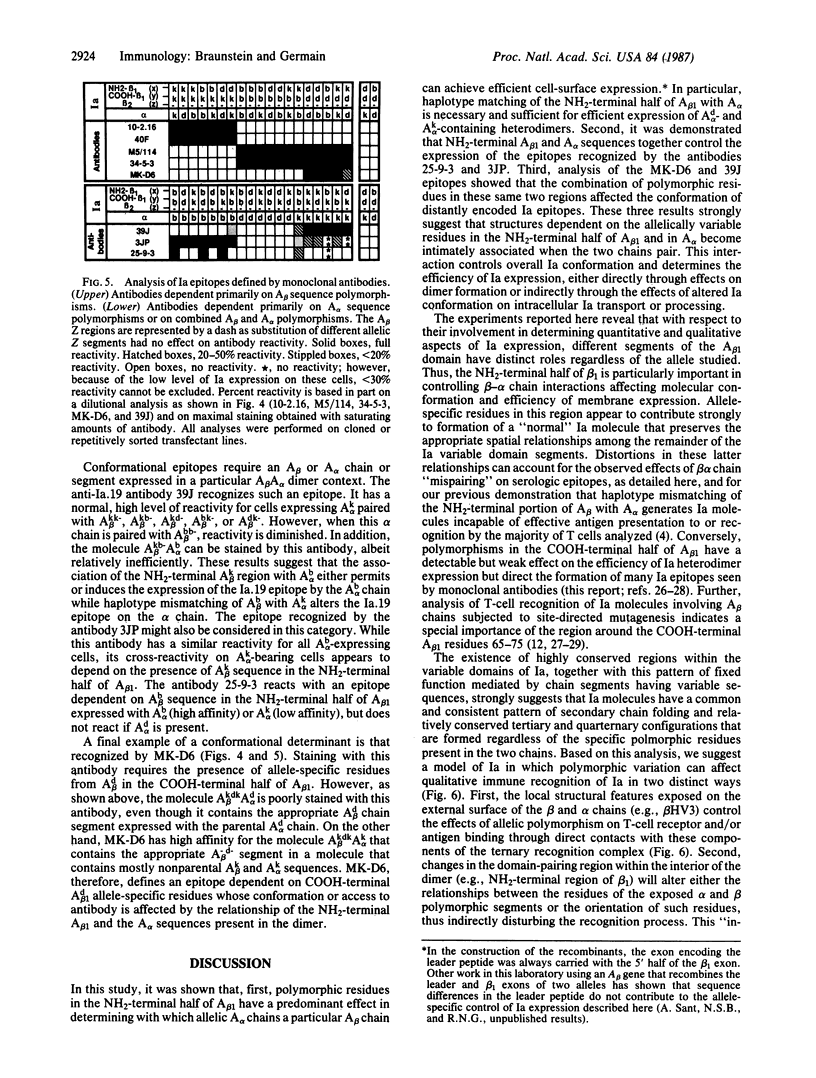
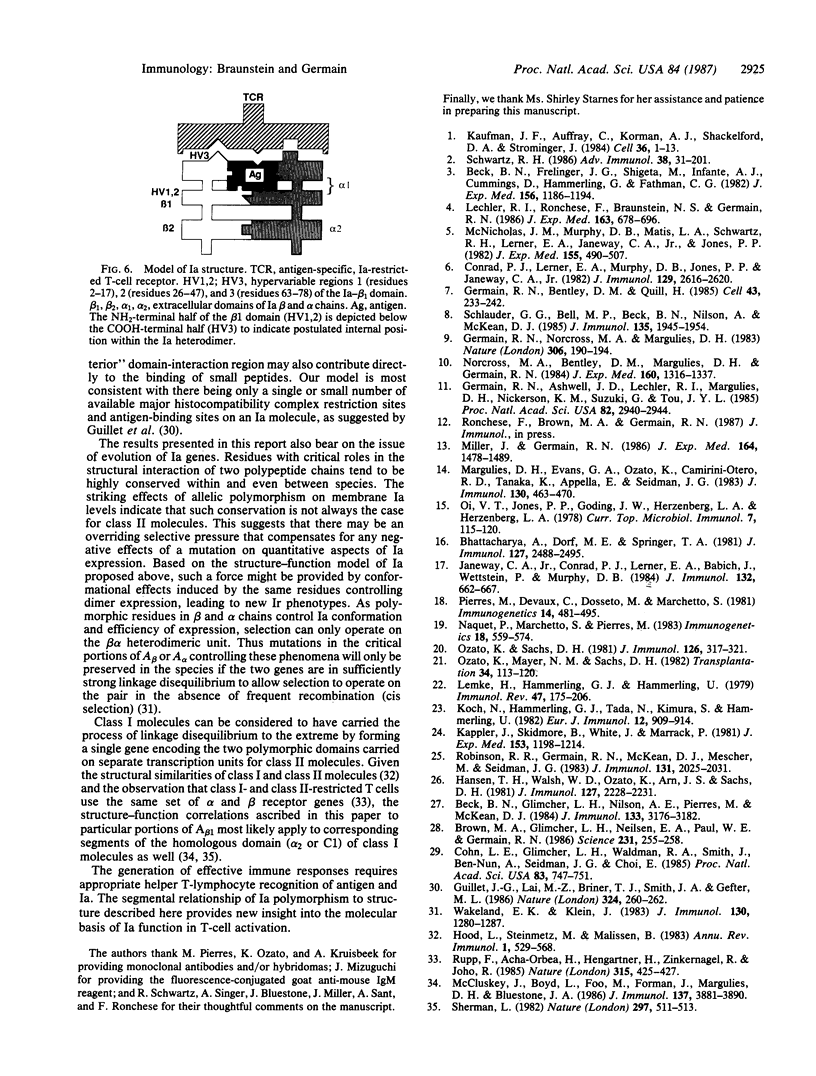
Images in this article
Selected References
These references are in PubMed. This may not be the complete list of references from this article.
- Beck B. N., Frelinger J. G., Shigeta M., Infante A. J., Cummings D., Hämmerling G., Fathman C. G. T cell clones specific for hybrid I-A molecules. Discrimination with monoclonal anti-I-Ak antibodies. J Exp Med. 1982 Oct 1;156(4):1186–1194. doi: 10.1084/jem.156.4.1186. [DOI] [PMC free article] [PubMed] [Google Scholar]
- Beck B. N., Glimcher L. H., Nilson A. E., Pierres M., McKean D. J. The structure-function relationship of I-A molecules: correlation of serologic and functional phenotypes of four I-Ak mutant cell lines. J Immunol. 1984 Dec;133(6):3176–3182. [PubMed] [Google Scholar]
- Bhattacharya A., Dorf M. E., Springer T. A. A shared alloantigenic determinant on Ia antigens encoded by the I-A and I-E subregions: evidence for I region gene duplication. J Immunol. 1981 Dec;127(6):2488–2495. [PubMed] [Google Scholar]
- Brown M. A., Glimcher L. A., Nielsen E. A., Paul W. E., Germain R. N. T-cell recognition of Ia molecules selectively altered by a single amino acid substitution. Science. 1986 Jan 17;231(4735):255–258. doi: 10.1126/science.3484558. [DOI] [PubMed] [Google Scholar]
- Cohn L. E., Glimcher L. H., Waldmann R. A., Smith J. A., Ben-Nun A., Seidman J. G., Choi E. Identification of functional regions on the I-Ab molecule by site-directed mutagenesis. Proc Natl Acad Sci U S A. 1986 Feb;83(3):747–751. doi: 10.1073/pnas.83.3.747. [DOI] [PMC free article] [PubMed] [Google Scholar]
- Conrad P. J., Lerner E. A., Murphy D. B., Jones P. P., Janeway C. A., Jr Differential expression of Ia glycoprotein complexes in F1 hybrid mice detected with alloreactive cloned T cell lines. J Immunol. 1982 Dec;129(6):2616–2620. [PubMed] [Google Scholar]
- Germain R. N., Ashwell J. D., Lechler R. I., Margulies D. H., Nickerson K. M., Suzuki G., Tou J. Y. "Exon-shuffling" maps control of antibody- and T-cell-recognition sites to the NH2-terminal domain of the class II major histocompatibility polypeptide A beta. Proc Natl Acad Sci U S A. 1985 May;82(9):2940–2944. doi: 10.1073/pnas.82.9.2940. [DOI] [PMC free article] [PubMed] [Google Scholar]
- Germain R. N., Bentley D. M., Quill H. Influence of allelic polymorphism on the assembly and surface expression of class II MHC (Ia) molecules. Cell. 1985 Nov;43(1):233–242. doi: 10.1016/0092-8674(85)90028-5. [DOI] [PubMed] [Google Scholar]
- Germain R. N., Norcross M. A., Margulies D. H. Functional expression of a transfected murine class II MHC gene. Nature. 1983 Nov 10;306(5939):190–194. doi: 10.1038/306190a0. [DOI] [PubMed] [Google Scholar]
- Guillet J. G., Lai M. Z., Briner T. J., Smith J. A., Gefter M. L. Interaction of peptide antigens and class II major histocompatibility complex antigens. Nature. 1986 Nov 20;324(6094):260–262. doi: 10.1038/324260a0. [DOI] [PubMed] [Google Scholar]
- Hansen T. H., Walsh W. D., Ozato K., Arn J. S., Sachs D. H. Ia specificities on parental and hybrid cells of an I-A mutant mouse strain. J Immunol. 1981 Dec;127(6):2228–2231. [PubMed] [Google Scholar]
- Hood L., Steinmetz M., Malissen B. Genes of the major histocompatibility complex of the mouse. Annu Rev Immunol. 1983;1:529–568. doi: 10.1146/annurev.iy.01.040183.002525. [DOI] [PubMed] [Google Scholar]
- Janeway C. A., Jr, Conrad P. J., Lerner E. A., Babich J., Wettstein P., Murphy D. B. Monoclonal antibodies specific for Ia glycoproteins raised by immunization with activated T cells: possible role of T cellbound Ia antigens as targets of immunoregulatory T cells. J Immunol. 1984 Feb;132(2):662–667. [PubMed] [Google Scholar]
- Kappler J. W., Skidmore B., White J., Marrack P. Antigen-inducible, H-2-restricted, interleukin-2-producing T cell hybridomas. Lack of independent antigen and H-2 recognition. J Exp Med. 1981 May 1;153(5):1198–1214. doi: 10.1084/jem.153.5.1198. [DOI] [PMC free article] [PubMed] [Google Scholar]
- Kaufman J. F., Auffray C., Korman A. J., Shackelford D. A., Strominger J. The class II molecules of the human and murine major histocompatibility complex. Cell. 1984 Jan;36(1):1–13. doi: 10.1016/0092-8674(84)90068-0. [DOI] [PubMed] [Google Scholar]
- Koch N., Hämmerling G. J., Tada N., Kimura S., Hämmerling U. Cross-blocking studies with monoclonal antibodies against I-A molecules of haplotypes b, d and k. Eur J Immunol. 1982 Nov;12(11):909–914. doi: 10.1002/eji.1830121103. [DOI] [PubMed] [Google Scholar]
- Lechler R. I., Ronchese F., Braunstein N. S., Germain R. N. I-A-restricted T cell antigen recognition. Analysis of the roles of A alpha and A beta using DNA-mediated gene transfer. J Exp Med. 1986 Mar 1;163(3):678–696. doi: 10.1084/jem.163.3.678. [DOI] [PMC free article] [PubMed] [Google Scholar]
- Lemke H., Hämmerling G. J., Hämmerling U. Fine specificity analysis with monoclonal antibodies of antigens controlled by the major histocompatibility complex and by the Qa/TL region in mice. Immunol Rev. 1979;47:175–206. doi: 10.1111/j.1600-065x.1979.tb00293.x. [DOI] [PubMed] [Google Scholar]
- Margulies D. H., Evans G. A., Ozato K., Camerini-Otero R. D., Tanaka K., Appella E., Seidman J. G. Expression of H-2Dd and H-2Ld mouse major histocompatibility antigen genes in L cells after DNA-mediated gene transfer. J Immunol. 1983 Jan;130(1):463–470. [PubMed] [Google Scholar]
- McCluskey J., Boyd L., Foo M., Forman J., Margulies D. H., Bluestone J. A. Analysis of hybrid H-2D and L antigens with reciprocally mismatched aminoterminal domains: functional T cell recognition requires preservation of fine structural determinants. J Immunol. 1986 Dec 15;137(12):3881–3890. [PubMed] [Google Scholar]
- McNicholas J. M., Murphy D. B., Matis L. A., Schwartz R. H., Lerner E. A., Janeway C. A., Jr, Jones P. P. Immune response gene function correlates with the expression of an Ia antigen. I. Preferential association of certain Ae and E alpha chains results in a quantitative deficiency in expression of an Ae:E alpha complex. J Exp Med. 1982 Feb 1;155(2):490–507. doi: 10.1084/jem.155.2.490. [DOI] [PMC free article] [PubMed] [Google Scholar]
- Miller J., Germain R. N. Efficient cell surface expression of class II MHC molecules in the absence of associated invariant chain. J Exp Med. 1986 Nov 1;164(5):1478–1489. doi: 10.1084/jem.164.5.1478. [DOI] [PMC free article] [PubMed] [Google Scholar]
- Naquet P., Marchetto S., Pierres M. Dissection of the Poly(Glu60Ala30Tyr10) (GAT)-specific T-cell repertoire in H-2Ik mice. II. The use of monoclonal antibodies to study the recognition of Ia antigens by GAT-reactive T-cell clones. Immunogenetics. 1983;18(6):559–574. doi: 10.1007/BF00345964. [DOI] [PubMed] [Google Scholar]
- Norcross M. A., Bentley D. M., Margulies D. H., Germain R. N. Membrane Ia expression and antigen-presenting accessory cell function of L cells transfected with class II major histocompatibility complex genes. J Exp Med. 1984 Nov 1;160(5):1316–1337. doi: 10.1084/jem.160.5.1316. [DOI] [PMC free article] [PubMed] [Google Scholar]
- Oi V. T., Jones P. P., Goding J. W., Herzenberg L. A., Herzenberg L. A. Properties of monoclonal antibodies to mouse Ig allotypes, H-2, and Ia antigens. Curr Top Microbiol Immunol. 1978;81:115–120. doi: 10.1007/978-3-642-67448-8_18. [DOI] [PubMed] [Google Scholar]
- Ozato K., Mayer N. M., Sachs D. H. Monoclonal antibodies to mouse major histocompatibility complex antigens. Transplantation. 1982 Sep;34(3):113–120. doi: 10.1097/00007890-198209000-00001. [DOI] [PubMed] [Google Scholar]
- Ozato K., Sachs D. H. Monoclonal antibodies to mouse MHC antigens. III. Hybridoma antibodies reacting to antigens of the H-2b haplotype reveal genetic control of isotype expression. J Immunol. 1981 Jan;126(1):317–321. [PubMed] [Google Scholar]
- Pierres M., Devaux C., Dosseto M., Marchetto S. Clonal analysis of B- and T-cell responses to Ia antigens. I. Topology of epitope regions on I-Ak and I-Ek molecules analyzed with 35 monoclonal alloantibodies. Immunogenetics. 1981 Dec;14(6):481–495. doi: 10.1007/BF00350120. [DOI] [PubMed] [Google Scholar]
- Robinson R. R., Germain R. N., McKean D. J., Mescher M., Seidman J. G. Extensive polymorphism surrounding the murine Ia A beta chain gene. J Immunol. 1983 Oct;131(4):2025–2031. [PubMed] [Google Scholar]
- Rupp F., Acha-Orbea H., Hengartner H., Zinkernagel R., Joho R. Identical V beta T-cell receptor genes used in alloreactive cytotoxic and antigen plus I-A specific helper T cells. 1985 May 30-Jun 5Nature. 315(6018):425–427. doi: 10.1038/315425a0. [DOI] [PubMed] [Google Scholar]
- Schlauder G. G., Bell M. P., Beck B. N., Nilson A., McKean D. J. The structure-function relationship of I-A molecules: a biochemical analysis of I-A polypeptides from mutant antigen-presenting cells and evidence of preferential association of allelic forms. J Immunol. 1985 Sep;135(3):1945–1954. [PubMed] [Google Scholar]
- Schwartz R. H. Immune response (Ir) genes of the murine major histocompatibility complex. Adv Immunol. 1986;38:31–201. doi: 10.1016/s0065-2776(08)60006-1. [DOI] [PubMed] [Google Scholar]
- Sherman L. A. Recognition of conformational determinants on H-2 by cytolytic T lymphocytes. Nature. 1982 Jun 10;297(5866):511–513. doi: 10.1038/297511a0. [DOI] [PubMed] [Google Scholar]
- Wakeland E. K., Klein J. Evidence for minor structural variations of class II genes in wild and inbred mice. J Immunol. 1983 Mar;130(3):1280–1287. [PubMed] [Google Scholar]





